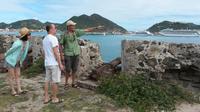St Maarten History Tour
Philipsburg, Sint Maarten
Rating: 









Trip Type: Historical & Heritage Tours
Duration: 4 hours
St Maarten/St Martin has a unique and fascinating history. This Dutch and French Caribbean island is the smallest island divided by two nations, and makes up for some interesting stories. This Half-day history tour of Dutch St Maarten and French St Martin takes you around the entire island while visiting historic landmarks and beautiful viewpoints. With a maximum of 6 guests per group, you'll receive personalized attention from your guide. Learn about St Maarten/ St Martin’s culture, geological and natural history.
More About This Activity All Historical & Heritage Tours →
St Maarten/St Martin has a unique and fascinating history. This Dutch and French Caribbean island is the smallest island divided by two nations, and makes up for some interesting stories. This Half-day history tour of Dutch St Maarten and French St Martin takes you around the entire island while visiting historic landmarks and beautiful viewpoints. With a maximum of 6 guests per group, you'll receive personalized attention from your guide. Learn about St Maarten/ St Martin’s culture, geological and natural history.The tour will start from Dock Maarten, Philipsburg. Depending on the weather, the size and level of fitness of the group the following sites will be visited while driving around entire St Martin.
Geological History
St Martin mainly consists of sand, limestone and layered rock. You'll visit one of the two sites where layered rock is clearly visible.
Forts
St Martin has the remains of three forts of which at least one will be visited. Each fort offers a great view of one of the two capitals St Martin is rich and form a lovely background for the conquest and pirate stories of St Martin. The forts are situated on top of hills and will take a 15 minute uphill walk to reach them.
Salt Pond
The first inhabitants of St Martin, the Arawak, called the island Soualiga meaning Land of Salt. The naturally producing salt ponds of St Martin were also the reason for the Dutch to return after they had an unplanned stop over on St Martin in 1624. You'll learn what Great Salt Pond looked like in her hey day and you’ll be able to see the difference in her appearance today.
Plantation
For centuries St Martin’s economy was based on salt production and agriculture during the plantation era. Of the more than 100 plantations in the colonial peak times only two – Golden Rock and Industry – have been conserved in one big park called the Emilio Wilson Estate. In the park remains of the plantation house and ruins of the surrounding farm buildings can be found. You'll visit this park to give the hardships of those times a moment of thought as well as enjoy the lovely scenery and marvelous trees in the park.
More
During this island tour more historical highlights will be pointed out such as the areas where the Amerindians once lived and the border monument celebrating the peaceful sharing between the Dutch and the French of 'The Friendly Island' St Martin. There will also be a break for iced tea, iced coffee and homemade cake with a Caribbean twist. After the tour, you will be returned to the starting point.
This tour is not suited for people who have problems walking on uneven and sloping terrain. Please be aware there will be at least one 15 minute walk uphill to visit a fort
Geological History
St Martin mainly consists of sand, limestone and layered rock. You'll visit one of the two sites where layered rock is clearly visible.
Forts
St Martin has the remains of three forts of which at least one will be visited. Each fort offers a great view of one of the two capitals St Martin is rich and form a lovely background for the conquest and pirate stories of St Martin. The forts are situated on top of hills and will take a 15 minute uphill walk to reach them.
Salt Pond
The first inhabitants of St Martin, the Arawak, called the island Soualiga meaning Land of Salt. The naturally producing salt ponds of St Martin were also the reason for the Dutch to return after they had an unplanned stop over on St Martin in 1624. You'll learn what Great Salt Pond looked like in her hey day and you’ll be able to see the difference in her appearance today.
Plantation
For centuries St Martin’s economy was based on salt production and agriculture during the plantation era. Of the more than 100 plantations in the colonial peak times only two – Golden Rock and Industry – have been conserved in one big park called the Emilio Wilson Estate. In the park remains of the plantation house and ruins of the surrounding farm buildings can be found. You'll visit this park to give the hardships of those times a moment of thought as well as enjoy the lovely scenery and marvelous trees in the park.
More
During this island tour more historical highlights will be pointed out such as the areas where the Amerindians once lived and the border monument celebrating the peaceful sharing between the Dutch and the French of 'The Friendly Island' St Martin. There will also be a break for iced tea, iced coffee and homemade cake with a Caribbean twist. After the tour, you will be returned to the starting point.
This tour is not suited for people who have problems walking on uneven and sloping terrain. Please be aware there will be at least one 15 minute walk uphill to visit a fort
« Go Back

